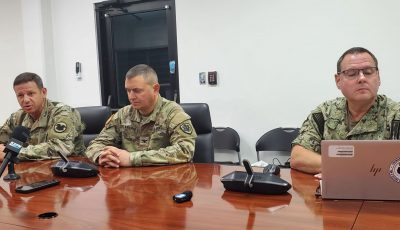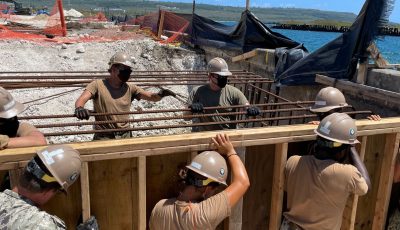Tinian mayor: Redo flawed EIS
San Nicolas demands ‘environmental justice’
Tinian Mayor Joey Patrick San Nicolas released yesterday a letter sent to the U.S. military, arguing its failures in analyzing the impact of proposed live-fire training on Tinian. The letter calls all military training alternatives on Tinian an end to economic viability, destruction of land and resources, and a denial of the Tinian’s people right to live in a safe and healthy environment.
The letter—sent on Sept. 14 as part of the comment period for the National Environmental Policy Act—formalizes and reiterates Tinian’s concerns over the military’s proposal.
The Marine Corps Forces Pacific has laid out plans for four range complexes on Tinian inclusive of grenade, tank, pistol, and mortar training, and restricted airspace. They plan to build on land they lease—the northern two-thirds of Tinian.
But San Nicolas says this activity would be an “economic chokehold” on Tinian, noting its growing tourism industry, and denial of customary and traditional rights as live-fire operations would limit access to gathering and fishing sites.
San Nicolas is also concerned at the apparent lack of mitigation for the construction and operation of live-fire ranges. Up to 3,000 personnel will be on Tinian during operations phase, essentially doubling the island’s population during these times. DoD says this will cause “no significant impact”
In a nutshell, the letter describes “legal deficiencies” with the CNMI Joint Military Training EIS and demands that the military rethink its plans.
“Let us be clear: the people of Tinian oppose and will continue to oppose any plans to carry out the training described in the CJMT EIS. We will do everything that we can—legally, politically, and socially—to protect our families, our culture, and our island.”
San Nicolas demands that the Department of Defense:
Provide the people of Tinian with an accurate assessment of environmental justice concerns;
Prepare a single environmental impact statement that addresses all connected and cumulative actions that will impact the island of Tinian and the CNMI;
Correct a flawed discussion with regards to alternatives discussed in the DEIS;
Comply with the National Historic Preservation Act;
Adequately assess the impacts to endangered species as required by the Endangered Species Act; and
Adequately assess the impact to marine mammals required by the Marine Mammals Protection Act.
Marianas Forces Pacific was sent a request for comment but Saipan Tribune did not receive a response as of press time.
Environmental justice
San Nicolas argues that the military’s plans—as laid out in the EIS—fails on a level of environmental justice, falling short of even acknowledging these issues as coherent, or salient, and incorrectly dismissing impacts that would seem prevalent and clear to the people on the island.
San Nicolas notes a presidential directive—an executive order from the White House in 1994—that tasks federal agencies to safeguard how their proposed actions affect minority populations, low-income populations, and indigenous peoples.
That directive, Executive Order 12898, tasks federal agencies to identify and address “disproportionately high and adverse human health or environmental effects of its programs, policies, and activities on minority populations and low-income populations in the United States and its territories and possessions, the District of Columbia, the Commonwealth of Puerto Rico, and the Commonwealth of the Mariana Islands.”
San Nicolas cites records and the EIS to say that 98 percent of the people on Tinian are minorities, and how 44 percent of the population is “low income
San Nicolas says Defense has taken the position in their impact statement that because all of Tinian is considered a minority and low-income area, there are no environmental justice issues.
As an example, San Nicolas cites the DEIS in saying that over 1,000 people on Saipan and Tinian will be exposed to noise levels of 115 decibels during 10 percent to 15 percent of the total training time proposed under CJMT. This noise level is comparable to the sound of the siren on an emergency vehicle, a firework, or “being near a rock band,” San Nicolas said, citing the EIS.
The residents affected by these impacts live in minority and low-income areas, San Nicolas said, but the DEIS “then incredibly concludes that the impact would not be considered disproportional as all of the CNMI is considered a minority and low-income area.”
“DOD’s inane interpretation of environmental justice is that if an action affects only minority and low-income populations, there is no disproportionate impact,” San Nicolas writes. “Therefore, DOD can claim that there [are] no environmental justice issues to analyze. DOD’s policy appears to encourage targeting islands and areas that are comprised solely of minority populations, low-income populations, and indigenous peoples.”
San Nicolas notes that the DEIS details cumulative impact on soil, noise pollution, airspace, land and submerged lands use, recreational resources, terrestrial biology, marine biology, visual resources, cultural resources, socioeconomics, and environmental justice.
“In the CNMI, it will be the people of Tinian that will disproportionately have to bear the significant impacts of the proposed activities as all the alternatives involve the use of Tinian… The impacts of the CJMT would fall disproportionately on the islands Tinian and Pagan.”
Inconsistent statements
San Nicolas says DoD has lacked transparency in its outreach.
Citing an earlier Saipan Tribune article in June, San Nicolas quotes Marforpac executive director Craig Whelden saying that there would not be a “bombing range.”
Whelden said then that DoD has “also consistently said that high hazard impact area would be limited to the volcanic area in the north, thereby protecting and reserving flora and fauna.” But expanding on this “high hazard area,” San Nicolas cites the EIS, which notes 175 2,000-lb aviation ordnance, 175 1,000-lb aviation ordnance, and 175 500-lb aviation ordnance that would be dropped on Pagan every year.
“It is the inconsistency between statements made by DOD representatives and the actual DEIS that have created confusion over what exactly DOD’s plans are in the CJMT. It is also the reason why many people in the CNMI have come to doubt the credibility of the DOD officials who have been handling the NEPA process. When DOD prepares another EIS, it should make a real effort to obtain input from the local community in the decision-making process, employ a strategy that encourages public participation rather than simply going through the motions, and be transparent about the planned actions and impacts,” San Nicolas said.
Bigger, connected picture
San Nicolas’s letter also draws a picture of the cumulative and connected impacts of several DoD projects that he believes DoD has failed to combine and analyze for the public together.
This failure frustrates the ability of the community to analyze and comment on the impacts of these actions on Tinian and the Mariana Islands as a whole, San Nicolas said.
Citing Council for Environmental Quality regulations, San Nicolas says all “connected actions” must be considered in a single EIS. These are the Guam-CNMI relocation, CJMT, and Marianas Islands Training and Testing, or MITT EIS which all purport impacts to Tinian.
San Nicolas notes that the notice of intent for the MITT EIS, which described expansive sonar, undersea, and bombing training, was issued in September 2011, and expanded on an earlier EIS, the Marianas Islands Range Complex.
The MITT draft was released in September 2013, or six months after DOD filed the notice intent for the CJMT. The final MITT EIS was released in May 2015, San Nicolas said.
“It is evident from the record that DOD was planning all of these actions simultaneously, but elected to release three separate EIS’s and conduct three separate NEPA processes rather than preparing a single document,” San Nicolas said.



























